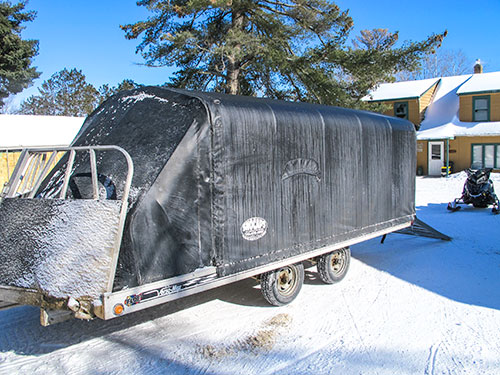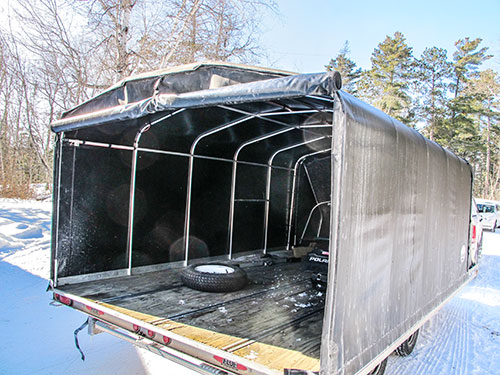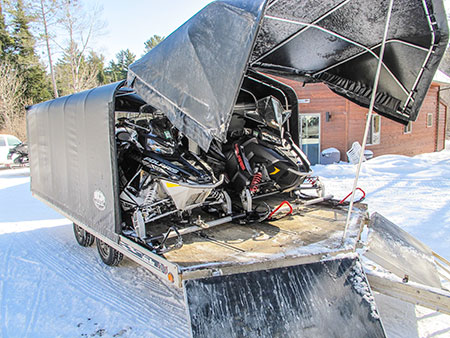Canvasworks SnoCap Trailer Enclosure Review

Editor’s Note: In each issue of Snow Goer magazine, our team of experienced product testers reviews various aftermarket products in the Cold Tested department. This review was printed in the January 2016 issue of Snow Goer. Subscribe to Snow Goer now to receive such reviews, 7 times per year delivered to your home.
Our 16-foot Floe snowmobile trailer was about eight years old last fall, but due to its open design it hadn’t gotten much use recently because our other trailers were enclosed models that provided a hassle-free way to keep sleds clean while on the road.
About 40 miles from the Snow Goer magazine shop is Canvasworks, a company that makes SnoCaps trailer enclosures out of the same soft-sided, heavy-duty material that’s used on over-the-road semi trailers. Seeing SnoCaps on highways and at trailhead lots piqued our interest, and after a ringing endorsement by a friend who’s had one on his Triton trailer for a few years, we took the plunge and had one installed on our Floe.
The ProSeries enclosure on our trailer includes a tilt-open nose and a roll-up rear door. We chose the 65-inch tall version – the most-popular height sold by Canvasworks – so it would accommodate taller snowmobile windshields that we like to ride behind on cold days.

The cap was accessorized with a zippered fuel access slot on the driver’s side and interior LED light kit. Support for the canvas comes from a thick-walled, aluminum tube frame that is fastened to the trailer with self-tapping screws and welded 30.5 inches on center. Kits can be received and installed by the buyer, or installed at its factory in central Minnesota like ours was.
The rear of the cover has two separate zippers that each run vertically up one side and partially across the top. To load sleds, users open the zippers and roll up the material around a metal pipe sewn inside the bottom of the rear flap. The assembly can be buckled to stay up and out of the way while loading, or else for shorter people who can’t easily reach the buckle – just tossed up on the roof. To help ensure a tight seal, two heavy-duty, hook-and-loop straps wrap around the pipe when the cover is closed. A hefty flap that helps prevent moisture from getting through the zipper lies over the military-grade zippers.
Up front, a 4-inch wide flap – with hook-and-loop material on the vertical surfaces – follows the seam that separates the flip-up hatch and the main portion of the cover. To unload a snowmobile, users peel back that sticky material, raise the hatch upward by lifting on the handle, clip the support pole in the bracket on the floor and drive the machine out of the trailer.

The vinyl material on our SnoCap fits tightly, so while cruising at freeway speeds, there wasn’t any movement or flapping. The zipper and rear attachments held in place while towing, and even when frosted or covered with slush and snow, the large patches of hook-and-loop material reliably reconnected after we loaded up and closed the cover. The rig was easily managed – in terms of acceleration, braking and sway – by all of the half-ton pickups and SUVs that pulled it last winter.
As with many devices or wholegoods, experience makes products easier to use – and that proved true with our cap. For example, loading three sleds took a few tries to learn where, specifically, to park the two front machines so the hatch would completely close. Using it also is a somewhat physical affair because it’s necessary to jump up on the trailer deck to release the rear curtain from its clip or pull it down from the roof, and to manipulate the thick material so the roof flap will correctly lie over the seam between the hatch and main structure.
After one season we can’t evaluate long-term durability of our cap, but we see no reason why it won’t last for years. The vinyl material is robust, the frame provides a solid structure and all components fit well so parts can’t wiggle, wear or loosen through vibration. That excellent fit also kept our trailer’s contents clean and dry.
You can’t haphazardly drive in the sleds, strap them down and shut the doors like a conventional, hard-side trailer, but this is an excellent solution for snowmobilers who want to upgrade their flatbed trailers because it’s a well-engineered and well-built system made from quality materials. Despite that a few more steps are required to use a SnoCap-equipped trailer, it’s an effective, lightweight – Canvasworks claims shipping weight for a 16-foot kit like ours is 250 pounds – and economical way to reap the benefits of an enclosed trailer.
ProSeries SnoCap – $2,309 as tested
Canvasworks Inc.
Cokato, Minnesota
763/675-2975
snocaps.net

Can I get a price quote for a Snocap kit for a 8×10 snowmobile trailer?
Thanks,
I have a triton 20′ aluminum 4 place open trailer, about a 1996/97, and would like to cover it up, I’m very impressed with your product, I’m in Epping NH
Looking for a cover for my 12’ Triton Trailer with a salt shield.
I just got a quote to cover a 6.5 x 12 triton trailer. No flip ups. No extra doors. Just an opening in the back to get the utv in. He said about $4000.
Just wondering if you are still in business as I would like a price. My trailer is approximately 8’x 10’.